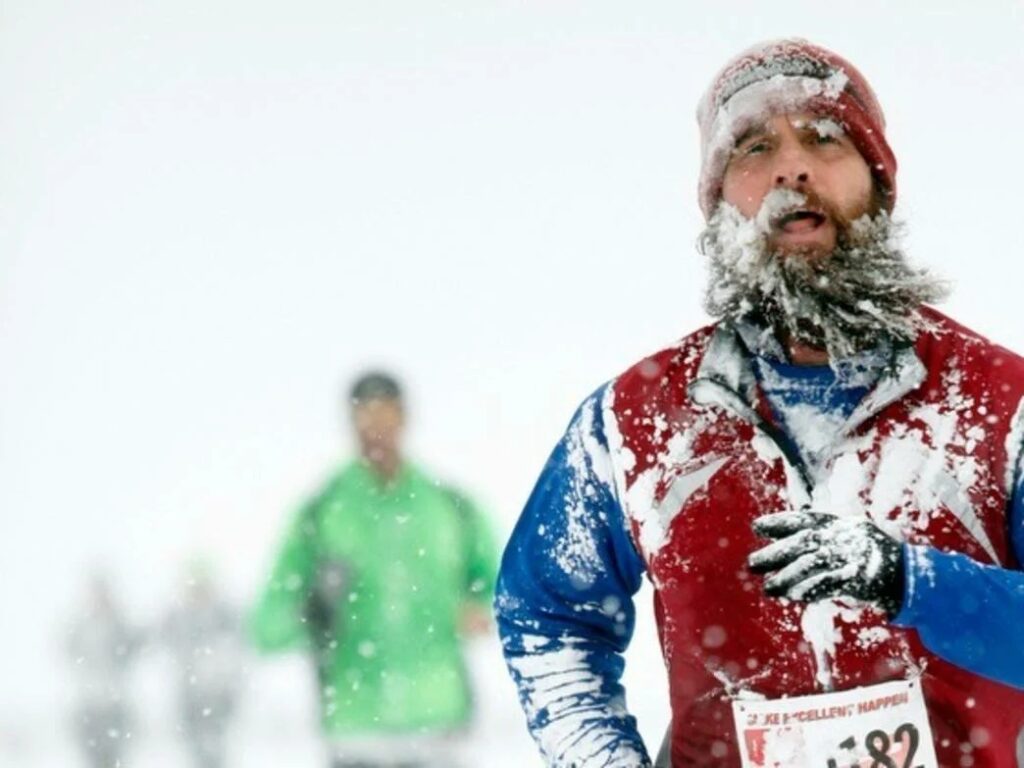Many running lovers interrupt their regular outdoor training with the arrival of winter, citing the cold and bad weather conditions.
But if you take into consideration some recommendations on clothing and running techniques, you can continue training in the fresh winter air and achieve new results.
Advantages of running in winter
1. Winter runs help strengthen the immune system, reducing the likelihood of colds.
2. There are also psychological benefits. The difficult conditions of winter running will make you purposeful, disciplined and responsible.
3. Cold increases the effectiveness of running workouts for those who want to lose weight. Low ambient temperature forces the body to expend more energy, since in addition to physical activity, it spends it on warming the body. Thus, the consumption of calories increases.
4. Overcoming slippery or uneven areas gives additional functional load and helps to strengthen the muscles that were not used in the summer when running on a comfortable surface.
How to breathe properly while running in winter
Run in the cold at a pace that allows you to inhale through your nose. If you need to open your mouth slightly while inhaling, you should press your tongue against the roof of your mouth. It is better to exhale through the mouth – this will completely clear the lungs of carbon dioxide.
Winter running clothes
1. Shoes
For wet asphalt, road running shoes are suitable, and for snow and ice, choose models with a good tread.
Usually, the feet stay warm due to constant movement, so there are enough summer sneakers. However, it is better that the sneakers are 0.5-1 size larger than usual, so that you can wear a tight sock or two at once.
2. Socks
The main thing is that the socks are not only warm, but also remove moisture, do not rub your feet.
In the cold, you can also use special trekking synthetic socks – like running socks, they remove moisture and keep you warm, even when wet.
3. Layering in clothing
The main principle in the selection of clothing for winter running is multilayering. The lower layer removes moisture, the middle layer retains heat, and the upper layer protects from wind and precipitation.
Thus, it is better to wear thermal underwear down, the second layer is fleece (it warms even when wet and removes moisture). Top layer: windbreakers, membrane jackets or sweatshirts made of windproof material such as WindStopper.
As the temperature decreases, you need to gradually increase the number of layers. And each person individually determines at what point he needs to get dressed for a run warmer.
4. Hats
The hat should remove sweat and excess heat outside.
The hat needs to “breathe” to keep you warm and cover my ears. In addition, it is better to choose a synthetic hat, since the wool is easier to blow and does not remove moisture.
5. Buff
Some runners prefer to train in the winter not in a hat, but in a buff. It protects the respiratory tract from cold air. However, if you breathe through the fabric, condensation will begin to form on it, which will then interfere with normal breathing.
6. Gloves
As in the case of a hat, it is better to use synthetic gloves. They should not only keep warm, but also remove moisture, as when running, your hands sweat a lot.
It is advisable that the gloves have windproof inserts that will protect your hands. In severe frosts, many runners switch from gloves to mittens, as they retain heat better.
How to run outdoors in winter and not catch a cold
-
- Before you start running, do a warm-up for all muscle groups. At the same time, it should be performed in a warm room, before going outside. Special attention should be paid to the foot. The warm-up should be as simple as possible – we need to warm up the muscles, not sweat.
- Dress according to the weather, you should not be either hot or cold. When you first go outside, it’s best to feel cool. If you are immediately warm, it is better to go back and change your clothes.
- Finish your run near your home, office, or at least by your car. After training, you should not be outside for a long time.
- When you get inside, change your clothes as quickly as possible and drink something hot.
Summery of Rules for running in winter
-
- Do low-intensity workouts on the street.
- Inhale through your nose and exhale through your mouth.
- Choose a route with cleared paths. If you have to run through snow and ice, put your feet carefully. Be as focused as possible on your run and don’t get distracted.
- Warm up at home before running.
- Choose sneakers, taking into account the surface on which you will run.
- Choose your clothes according to the weather conditions and personal thermoregulation. When you first went out for a run, you should be cool.
- Strengthen the muscles, ligaments-stabilizers and the ankle joint.
- Start running workouts in the warmer months, and let your body get used to running in the cold. If you start running in the winter, gradually increase the training time and the number of runs.

